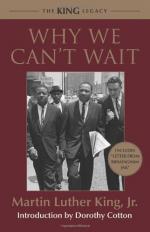|
This section contains 410 words (approx. 2 pages at 400 words per page) |

|
Why We Can't Wait Summary & Study Guide Description
Why We Can't Wait Summary & Study Guide includes comprehensive information and analysis to help you understand the book. This study guide contains the following sections:
This detailed literature summary also contains Topics for Discussion and a Free Quiz on Why We Can't Wait by Martin Luther King, Jr..
Martin Luther King, Jr.'s presentation of events and forces behind the Civil Rights Movement in "Why We Can't Wait" focuses on the activities surrounding the 1963 Birmingham lunch-counter sit-in demonstrations. In this study guide the use of the word "Negro" will be used, as it is the word that was used in the text and in the historical time period. The short historical introduction of two young Negro children trying to cope with the experience of their race in miserable living conditions provides the introductory backdrop for King's evaluation of the Negro Revolution. One hundred years after the Civil War and Emancipation Proclamation the American Negro still struggles to be free from shackles of slavery in other forms.
Birmingham is the largest and most segregated city in Alabama. Bull Connor, the city's Commissioner of Public Safety is the racist enforcer of the city's Jim Crow laws that keep the city segregated in Governor George Wallace's Alabama police state. The burning issue of the conflict focuses on the lunch-counter in Birmingham's department and drug stores. Negro shoppers in the stores are welcome to spend their hard-earned money buying merchandise on any counter there except for the counter where the white shoppers can take a seat to get a soda and sandwich or other snack. Negro customers are not allowed to buy food at the lunch counter in any Birmingham department or drug store. Other Jim Crow laws allow the use of only the facilities marked "Colored."
Martin Luther King, Jr. and his associates plan, develop and implement nonviolent resistance to eventually transform Birmingham, Alabama into a model city of integrated southern civility. This short history traces the American Negro's struggle from slavery through specific civil rights activities in Montgomery and Birmingham, Alabama to its climactic success in the March on Washington. "Why We Can't Wait" is King's look back to evaluate progress of American Negro civil rights since the Civil War era and the Emancipation Proclamation. The book is written and published in the 1960s with an Afterword written in 1999 by Reverend Jesse L. Jackson, Sr. Double-sided photographic inserts provide a dramatic presentation of well-dressed leaders contrasted with thuggish Birmingham police intimidating women and children. The short chapters titled like "The Sword That Heals" and "Black and White Together" flow together well. Text content is straightforward without flashback and images that may confuse reading. The order of events portrayed holds the readers attention in suspense and interest.
Read more from the Study Guide
|
This section contains 410 words (approx. 2 pages at 400 words per page) |

|



